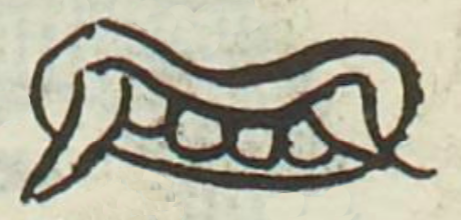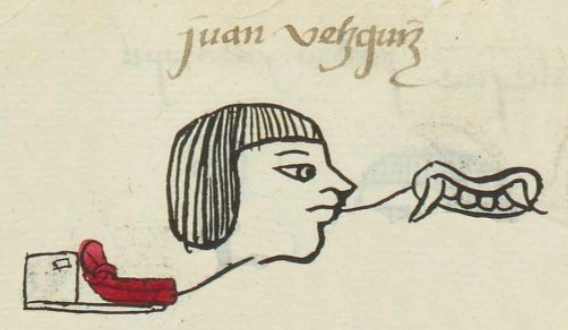Huetzquiz (MH529r)
This black-line drawing of the simplex glyph for the personal name Huetzquiz (“Laughter,” attested here as a man’s name) shows a frontal view of a mouth with curving lips and four, upper, front teeth and two very prominent canine teeth. The gloss suggests that "laughter" (huetzquiztli) seems to be the intention for the name--more than teeth (tlantli) or fangs like the (coatlane) (which appears in the translation Florentine Codex, 1963, Book 11, p. 5).
Stephane Wood
The presence of such large canines calls to mind thorns (huitztli), which could play a role in the name. Perhaps also the verb quiza, to go out, refers to the showing of the teeth. Protruding fangs, such as those on the biting bat (below), were often colored red and white like thorns, possibly pointing to the role of sharp objects being used for bloodletting. See also the glyph for the Huetzquiz name on MH666r, which has a full face with a mouth like this one.
There was a mid-sixteenth-century ruler of Tenochtitlan, Tehuetzquiti, who had a glyph much like the full face of Huetzquiz that appears on f. 666r of the Matrícula de Huexotzinco. That glyph of the ruler is found in the Codex Aubin. And tehuetzquiti refers to making people laugh or frightening them.
Stephanie Wood
juan vetzquiz
Juan Huetzquiz
Stephanie Wood
1560
Jeff Haskett-Wood
sonrisas, risa, smiles, fangs, teeth, dientes, colmillos, nombres de hombres

huetzquiz(tli), laughter or a smile, https://nahuatl.wired-humanities.org/content/huetzquiztli
tehuetzquiti, a buffoon or joker, makes people laugh or frightens them, and the name of a governor of Tenochtitlan in the 16th c., https://nahuatl.wired-humanities.org/content/tehuetzquiti
huitz(tli), thorn, https://nahuatl.wired-humanities.org/content/huitztli
quiza, to emerge, go out, https://nahuatl.wired-humanities.org/content/quiza
Risa
Stephanie Wood
Matrícula de Huexotzinco, folio 529r, https://www.loc.gov/resource/gdcwdl.wdl_15282/?sp=137&st=image
This manuscript is hosted by the Library of Congress and the World Digital Library; used here with the Creative Commons, “Attribution-NonCommercial-ShareAlike 3.0 License” (CC-BY-NC-SAq 3.0).








